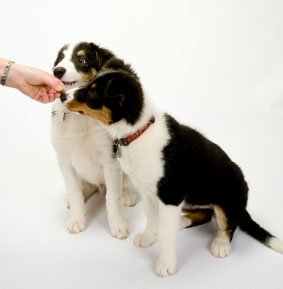Why dog keeps stealing other dogs toys ?

Why dog keeps stealing other dogs toys ? Protecting territory or resources is a trait that is highly prevalent and natural in dogs. Dogs are hardwired from birth to hoard valuable resources for themselves and avoid sharing them with others. Resources might come in the form of food, toys, or even the attention of the owner when it comes to domesticated dogs. The conduct of resource guarding is often confined to straightforward communication in the vast majority of homes; nevertheless, there are situations in which the behavior can become more frequent or intense, perhaps leading to harm. If you are ever concerned about aggressive behavior in your dog, regardless of whether or not it is related to resource guarding, it is best to seek the assistance of a qualified professional, such as your veterinarian or another qualified professional, before attempting to handle the situation on your own.
There are several guidelines that can lessen the amount of conflict that occurs between dogs and their people while they are guarding resources, but guarding against other dogs brings its own distinct set of issues. On the other hand, the fundamentals of working with a dog who defends resources against humans and working with a dog that guards resources against other canines are fundamentally same. Generally speaking, fear is the feeling that lies behind the conduct.
It is possible for wild animals to live or die depending on whether or not they are able to keep a meal for themselves. Even though the risk of starvation for treasured pets is extremely remote (in fact, it’s virtually nonexistent), the natural impulse to guard precious resources has not been eradicated. Any form of training should have as its primary objective the reduction or elimination of anxiety and conflict, with the end result being a dog that is more at ease when interacting with a resource. It is possible to alter a dog’s emotional reaction and level of motivation by employing techniques such as positive reinforcement and counter-conditioning. As a direct consequence of this, the problematic behavior ceases to exist.
Why dog keeps stealing other dogs toys ?
Steps to success
The most significant distinction that can be made between a dog defending against people and a dog guarding against other dogs is that the most of the time the human does not want the slimy, old rawhide resource, but the majority of the time the other dog does want it! When there are two dogs in the home, there are two different training chores that need to be addressed. The first step is to instruct the dog that is protecting the territory to feel less threatened whenever another dog approaches, and the second step is to instruct the dog that is coming up behind it not to take the items that belong to other dogs.
Implementing effective management practices to deter the resource-guarding behavior that has to be changed is the initial stage in the process of changing that behavior. The best way to improve is to practice! Create a list of the things, places, and circumstances that are likely to cause the dog to behave in a guarding manner. The next step is to either alter the surroundings so that the possibilities are no longer present or remove the dog from access to the area. This may include removing cherished toys, restricting access to specific rooms or pieces of furniture, crate training the dogs individually during mealtimes, or utilizing one of the many other management tactics available. The use of baby gates, crates, and pens are all excellent methods for controlling the space that your dog occupies and preventing undesired habits. Be aware that in some circumstances, dogs might need to be kept totally apart, with the exception of while they are being trained.
Train and treat the two
The next step is to begin collaborating with the dogs. You will need two people to help you, one to handle Dog A and another to handle Dog B. To begin, it’s best to work with an object that has a relatively modest value, something that your dog like but isn’t very enthusiastic about. The following is an example of a common hierarchy of resource values for many dogs: plush toys (low value), chewies (mid value), and food (high value).
The intention is that each and every encounter will be constructive and enlightening. Maintain at all times that the dog is “under threshold.” This indicates that if everything goes as it should, you won’t ever see any hostile conduct under any circumstances.
Both dogs ought to be on leashes before beginning for their own protection; the watchdog, Dog A, would even benefit from being tethered for added peace of mind. Learning without making mistakes is the objective, but it’s always best to err on the side of caution!
Put the resource in close proximity to Dog A. Bring in Dog B after that, making sure to halt a safe distance away from Dog A and well beyond the point where Dog A might possibly be worried. It is important to err on the side of caution because the appropriate distance will vary based on the dog. Click and reward Dog A for maintaining his composure as you guide Dog B away from the resource. Then, click and treat Dog B for avoiding going for the treat.
Repeat the process, this time moving Dogs A and B closer together and rewarding them with a click and a treat when they demonstrate the desired behavior. If at any time throughout the training session any of the dogs displays behavior that is not calm and relaxed, you should return to the previous distance at which they were both successful and continue from there. The distance should be gradually shortened in tiny increments until Dog B can walk directly by Dog A without eliciting any response from either dog.
At this point, you should return to the distance you were at when you started, but you should utilize a more precious resource. Repeat the previous procedures while keeping both dogs below the threshold at all times, and continue doing so until Dog B is able to walk directly past Dog A and both dogs are at ease. Repeat the procedure with resources that are progressively more valuable up until the point when you are dealing with the greatest material there is. You may also do this exercise in a variety of other settings, particularly in any spot that Dog A has a tendency to defend, such as the couch.
One for you, then one for you

Try another fun exercise. Sit the dogs far apart, one on either side of you, tethering if necessary. Say Dog B’s name and give him a medium-value treat. Immediately say Dog A’s name and give him an even better treat. If either dog appears uncomfortable at all, move them further apart and start again. Repeat until both dogs are holding their “sits” patiently while the other gets a treat. Gradually reduce the distance between the dogs until they are comfortable sitting as little as a body length apart.
Remember, safety first! Both dogs need to feel completely comfortable at all times. The goal of this exercise is to teach Dog A that when Dog B gets a treat, it predicts him getting an even better treat! Dog A will start anticipating Dog B’s treat because it means his own goodie is imminent.



